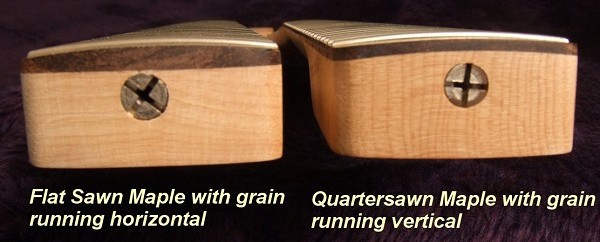When ordering a G&L guitar, there is quite a list of options to choose from. One of the lesser known options is whether to get the standard flat sawn neck, or the optional quarter sawn neck? So what is the difference and does it matter?
Nearly all production necks today are made from what is known as flat sawn lumber. I am not a wood expert, but essentially there is a greater yield of flat sawn lumber for necks when cutting up a tree. Greater yield means lower cost. How do you know if your neck is flat sawn? On a bolt-on maple neck guitar the easiest way to check is to look at the end of the neck where it butts up against the neck pocket. If the grain of the wood is parallel to the fingerboard, it’s flat sawn. The picture below is courtesy of Alberto Bolocan’s blog — or at least he used it too — and Alberto has some very detailed information on the various sawing techniques.

As you can see, the quarter sawn neck has the grain of the wood perpendicular to the fingerboard. Having the grain of the wood perpendicular to fingerboard results in a measurably stiffer neck. As you can imagine, bending a piece of wood with the grain is much easier than bending a piece of wood perpendicular or “against” the grain. The density of the quarter sawn lumber is sometimes higher too, also contributing to greater stiffness.
So you can expect a quarter sawn neck to be stiffer, and affected less by changes in weather. This is especially handy with bass guitars and their longer necks, or with guitarists that like to use heavier gauge strings. I find that when setting up a quarter sawn neck that they are naturally very flat, and sometimes it’s hard to get enough relief (bow) out of the neck. Changing up or down a gauge on strings will likely have no effect on a quarter sawn neck.
Quarter sawn necks are also felt to be brighter and more responsive than a flat sawn neck. This is due both to the increased stiffness of the neck and the higher density of the wood. I would generally agree with this observation, although it’s hard to make direct comparisons without actually changing necks on the same guitar. In general though quick attack and good note clarity are characteristic of a quarter sawn neck.
As a side benefit, the grain pattern of the headstock looks really neat when quarter sawn, especially with a vintage tint.
So is quarter sawn worth the money? This option typically adds about $75 to the price of a G&L, so for most people it’s not a deal breaker. If you tour, or live in an area with wide swings in temperature or humidity, a quarter sawn neck is absolutely more stable and will require fewer adjustments. The sonic differences are not dramatic, but if your preference run towards a snappy instrument with a solid attack it certainly cannot hurt. We recently received a custom order guitar — Classic Custom Semi Hollow — with a flame maple top and quarter sawn maple neck. The combination of reflective maple top and stiff neck resulted in a remarkably clean and detailed sound that really projected unlike a garden variety ASAT.
Whether it’s freedom from occasional adjustments or the desire for a more responsive instrument, a quarter sawn neck is a low cost option with obvious benefits.
